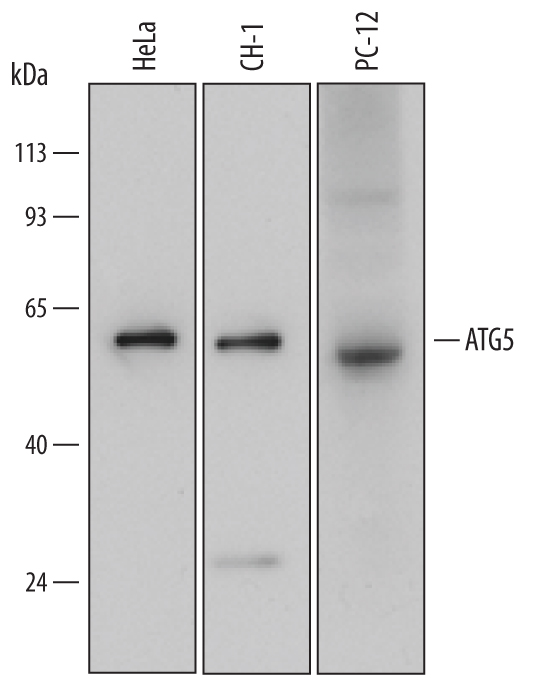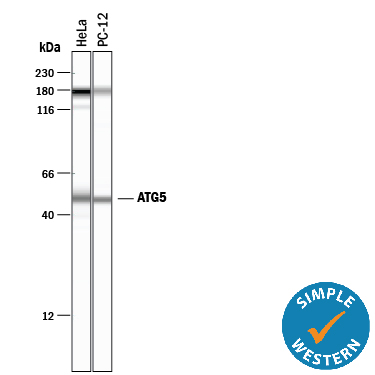Human/Mouse/Rat ATG5 Antibody Summary
Asn99-Thr193
Accession # Q9H1Y0
Applications
Please Note: Optimal dilutions should be determined by each laboratory for each application. General Protocols are available in the Technical Information section on our website.
Scientific Data
 View Larger
View Larger
Detection of Human, Mouse, and Rat ATG5 by Western Blot. Western blot shows lysates of HeLa human cervical epithelial carcinoma cell line, CH-1 mouse B cell lymphoma cell line, and PC-12 rat adrenal pheochromocytoma cell line. PVDF Membrane was probed with 0.5 µg/mL of Mouse Anti-Human/Mouse/Rat ATG5 Monoclonal Antibody (Catalog # MAB5294) followed by HRP-conjugated Anti-Mouse IgG Secondary Antibody (Catalog # HAF007). A specific band was detected for ATG5 at approximately 50 kDa (as indicated). This experiment was conducted under reducing conditions and using Immunoblot Buffer Group 2.
 View Larger
View Larger
Detection of Human and Rat ATG5 by Simple WesternTM. Simple Western lane view shows lysates of HeLa human cervical epithelial carcinoma cell line and PC‑12 rat adrenal pheochromocytoma cell line, loaded at 0.2 mg/mL. A specific band was detected for ATG5 at approximately 51 kDa (as indicated) using 25 µg/mL of Mouse Anti-Human/Mouse/Rat ATG5 Monoclonal Antibody (Catalog # MAB5294). This experiment was conducted under reducing conditions and using the 12-230 kDa separation system.
Reconstitution Calculator
Preparation and Storage
- 12 months from date of receipt, -20 to -70 °C as supplied.
- 1 month, 2 to 8 °C under sterile conditions after reconstitution.
- 6 months, -20 to -70 °C under sterile conditions after reconstitution.
Background: ATG5
ATG5 (Autophagy-related Protein), also known as APG5L and Apoptosis-specific Protein, is a ubiquitous 32 kDa member of the ATG family of proteins. ATG5 exists as a covalent heterodimer with ATG12 through the creation of a Lys-Gly linkage. The ATG5:ATG12 heterodimer associates noncovalently with an ATG16 multimer to generate autophagosomes. Human ATG5 is 275 amino acids in length and contains N- and C-terminal ubiquitin-like domains (aa 15‑105 and 187‑275) separated by a helix-rich linker region that contains a dimerizing Lys at position 130. There are two potential alternate start sites at Met80 and Met173. Over aa 99‑193, human ATG5 is 97% aa identical to mouse ATG5.
Product Datasheets
Citation for Human/Mouse/Rat ATG5 Antibody
R&D Systems personnel manually curate a database that contains references using R&D Systems products. The data collected includes not only links to publications in PubMed, but also provides information about sample types, species, and experimental conditions.
1 Citation: Showing 1 - 1
-
The DNA methyltransferase DNMT3A contributes to autophagy long-term memory
Authors: P González-R, M Cheray, J Füllgrabe, M Salli, P Engskog-Vl, L Keane, V Cunha, A Lupa, W Li, Q Ma, K Dreij, MG Rosenfeld, B Joseph
Autophagy, 2020-09-14;0(0):1-19.
Species: Human, Mouse
Sample Types: Cell Lysates
Applications: Western Blot
FAQs
No product specific FAQs exist for this product, however you may
View all Antibody FAQsReviews for Human/Mouse/Rat ATG5 Antibody
There are currently no reviews for this product. Be the first to review Human/Mouse/Rat ATG5 Antibody and earn rewards!
Have you used Human/Mouse/Rat ATG5 Antibody?
Submit a review and receive an Amazon gift card.
$25/€18/£15/$25CAN/¥75 Yuan/¥2500 Yen for a review with an image
$10/€7/£6/$10 CAD/¥70 Yuan/¥1110 Yen for a review without an image

